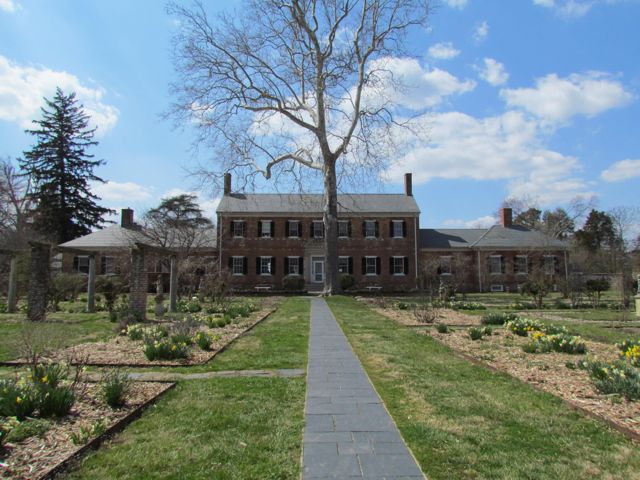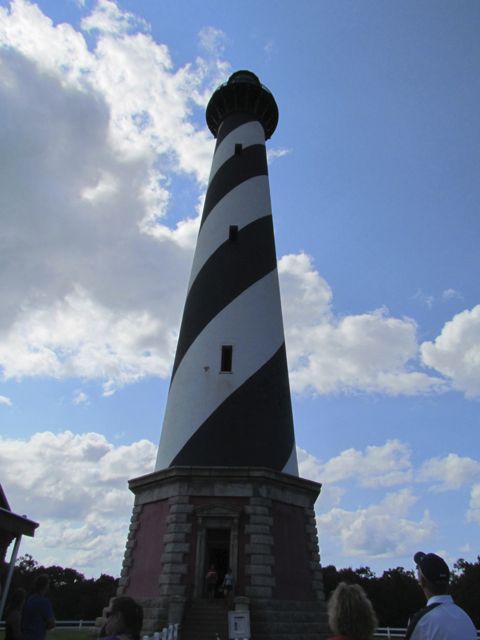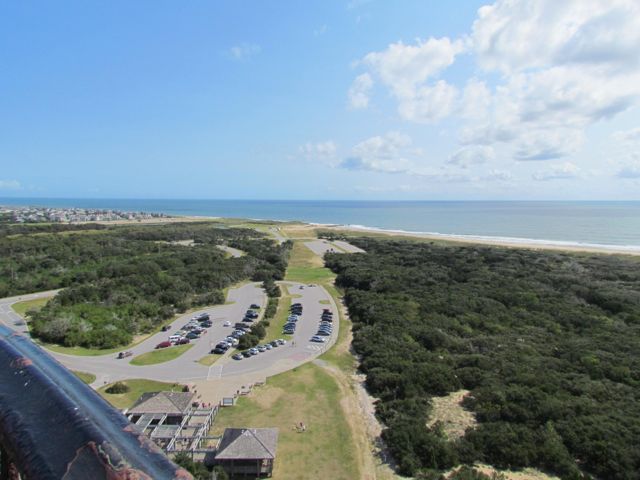 We were very fortunate to spend a few weekends in the NC mountains this summer. On our second mountain trip we met up with my in-laws and stayed in a beautiful mountain cabin near the Appalachian Ski Mountain between Boone and Blowing Rock. On a tip from friends, we headed out to the Blue Ridge Parkway and visited the Moses Cone Memorial Park & the Linn Cove Viaduct.
We were very fortunate to spend a few weekends in the NC mountains this summer. On our second mountain trip we met up with my in-laws and stayed in a beautiful mountain cabin near the Appalachian Ski Mountain between Boone and Blowing Rock. On a tip from friends, we headed out to the Blue Ridge Parkway and visited the Moses Cone Memorial Park & the Linn Cove Viaduct.
The Moses Cone Memorial Park is located along the Blue Ridge Parkway at MP 294, just a short drive from Blowing Rock. Moses Cone Memorial Park preserves the country estate of Moses Cone, who was a textile businessman and conservationist in the late 19th century. The park features 25 miles of hiking and bridle trails and Flat Top Manor, which is a 13,000 sq ft Colonial Style mansion. The bottom floor of the manor houses the Parkway Craft Center, which features handmade crafts by regional artists and a souvenir shop. We also had the pleasure of watching a pottery demonstration, which the craft center regularly schedules.
After the pottery demo and catching some breathtaking views outside the manor overlooking Bass Lake, we headed left of the house to walk the Figure 8 trail. This short 0.7 mile hike is great for families with small children or grandparents as it is well shaded and flat. Originally created by Moses Cone for his daily walks, this unpaved path meanders in a figure 8 shape through the property, making it a perfect walking trail to explore the variety of trees and flowers. Informational signs highlight the hickory, oak, maple, mountain laurel and black cherry trees along the trail. If you’re craving a longer or more strenuous hike, check out the map of trails around the park.
 After spending over an hour at the park, we turned left out of Moses Cone Memorial Park and headed 10 miles south to the Linn Cove Viaduct (MP 304). At an elevation of 4,100 ft, the Linn Cove Viaduct is a concrete bridge engineering marvel snaking around Grandfather Mountain; it is over 1,200 ft long and consists of 153 concrete sections weighing 50 tons each. Construction of the Linn Cove Viaduct was completed in 1983, cementing the final link of the Blue Ridge Parkway.
After spending over an hour at the park, we turned left out of Moses Cone Memorial Park and headed 10 miles south to the Linn Cove Viaduct (MP 304). At an elevation of 4,100 ft, the Linn Cove Viaduct is a concrete bridge engineering marvel snaking around Grandfather Mountain; it is over 1,200 ft long and consists of 153 concrete sections weighing 50 tons each. Construction of the Linn Cove Viaduct was completed in 1983, cementing the final link of the Blue Ridge Parkway.
Coming from the north, we drove over the viaduct and then turned left into the Linn Cove Viaduct Visitor Center parking lot. We hiked the short 0.2 mile walk along the Tanawha Trail to the Linn Cove Viaduct observation deck. Along the short walk we saw several mountain springs and a variety of mountain flora. Walking underneath the viaduct gives you a sense of the bridge’s massiveness – each bridge segment spans several arm-lengths in width, and has enormous amounts of concrete supported by large piers. We then walked higher up the Tanawha trail to get an eye-level view of the viaduct and mountains in the distance. Though our trip to the viaduct was quick, everyone in our group (not just the engineers) really enjoyed and appreciated seeing such an engineering feat up close.
Additional Resources:
- Moses Cone Memorial Park Hiking Map
- Construction of the Linn Cove Viaduct
- Tanawha Trail and Hiking Map around Linn Cove Viaduct
Thumbs up: beautiful views from Moses Cone Park overlooking downtown Blowing Rock, access to close-up views of viaduct, infinite outside experiences along Blue Ridge Parkway
Thumbs down: manor house in desperate need of painting and renovations, bathroom facilities at Moses Cone Park
















































 After walking back we headed over to the lighthouse to talk to the NPS rangers. We had a great conversation with the young rangers who shared some of their favorite facts about the lighthouse: 1) how the Confederate troops blew up the lighthouse to prevent Union troops from occupying it, 2) that the lighthouse still uses its original Fresnel lens from Paris and 3) how the lighthouse still aids in navigation today given its checkered history. Despite the high heat index they still allowed visitors to climb a few steps to the first landing. We explored the old oil storage rooms in the front and then took pictures of the amazing view up the heavy duty spiral staircase before heading out.
After walking back we headed over to the lighthouse to talk to the NPS rangers. We had a great conversation with the young rangers who shared some of their favorite facts about the lighthouse: 1) how the Confederate troops blew up the lighthouse to prevent Union troops from occupying it, 2) that the lighthouse still uses its original Fresnel lens from Paris and 3) how the lighthouse still aids in navigation today given its checkered history. Despite the high heat index they still allowed visitors to climb a few steps to the first landing. We explored the old oil storage rooms in the front and then took pictures of the amazing view up the heavy duty spiral staircase before heading out.

















































































 Today, Chatham Manor and its grounds are still beautiful and a symbol of the South. The entrance through the gardens is surrounded by a large brick wall. We visited at the beginning of Virginia’s spring season so the gardens were popping with daffodils. Other than the main house, there is a fish pond, kitchen, dairy barn, and greenhouse. The main house has exhibits that are open to visitors (our little visitor was not interested in walking through the house that day) but the other structures on the property are not open to the public. The back of the property overlooks the river, providing gorgeous views of downtown Fredericksburg. You can also see a replica cannon and pontoon bridge, similar to what General Burnside’s Union army used to cross the river in 1862.
Today, Chatham Manor and its grounds are still beautiful and a symbol of the South. The entrance through the gardens is surrounded by a large brick wall. We visited at the beginning of Virginia’s spring season so the gardens were popping with daffodils. Other than the main house, there is a fish pond, kitchen, dairy barn, and greenhouse. The main house has exhibits that are open to visitors (our little visitor was not interested in walking through the house that day) but the other structures on the property are not open to the public. The back of the property overlooks the river, providing gorgeous views of downtown Fredericksburg. You can also see a replica cannon and pontoon bridge, similar to what General Burnside’s Union army used to cross the river in 1862.































 So, last September (yes, I’m super slack) we headed on our annual trip to Nags Head with family and friends. This trip was super special because my aunt, who used to live in Charlottesville and now lives in CA, made a trip back east to spend the week with us. Being that she used to be the one taking us on adventures to the beach when we were young it was nice to experience it with her again.
So, last September (yes, I’m super slack) we headed on our annual trip to Nags Head with family and friends. This trip was super special because my aunt, who used to live in Charlottesville and now lives in CA, made a trip back east to spend the week with us. Being that she used to be the one taking us on adventures to the beach when we were young it was nice to experience it with her again. The lighthouse is operated by the National Park Service and open to the public for walking tours during the summer months so for only $7 I climbed the 240+ spiral staircase steps while Bill and Ashley scoped out the grounds and toured the light keeper’s quarters. As you can imagine, the stairway in the lighthouse is very narrow and rather steep, making two-way traffic crowded. At each “floor” there is a landing pad to rest with windows providing great views. But, the real views are when you get to the top of the lighthouse and skirt along the balcony. The railing is about 4ft high, allowing for great picture taking and breath-taking views for miles, which reminded me of views from the top of
The lighthouse is operated by the National Park Service and open to the public for walking tours during the summer months so for only $7 I climbed the 240+ spiral staircase steps while Bill and Ashley scoped out the grounds and toured the light keeper’s quarters. As you can imagine, the stairway in the lighthouse is very narrow and rather steep, making two-way traffic crowded. At each “floor” there is a landing pad to rest with windows providing great views. But, the real views are when you get to the top of the lighthouse and skirt along the balcony. The railing is about 4ft high, allowing for great picture taking and breath-taking views for miles, which reminded me of views from the top of 














































